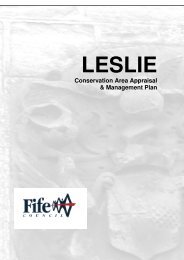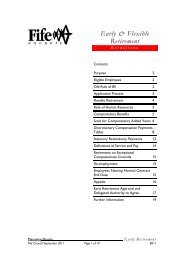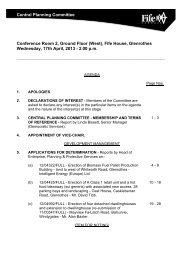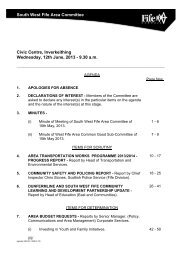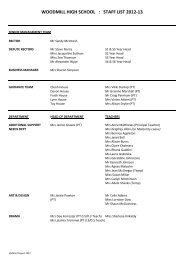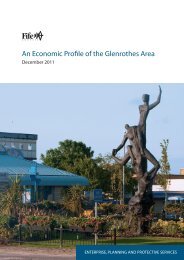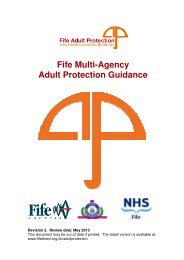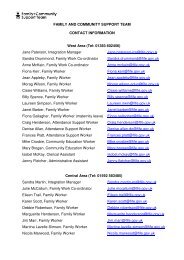the fife council - planning committee - glenrothes - Home Page
the fife council - planning committee - glenrothes - Home Page
the fife council - planning committee - glenrothes - Home Page
Create successful ePaper yourself
Turn your PDF publications into a flip-book with our unique Google optimized e-Paper software.
neighbourhood; <strong>the</strong> effect of noise limits on <strong>the</strong> number of kWh generated and <strong>the</strong> duration andlevel of exposure. ETSU permits higher noise levels at night than during <strong>the</strong> day as <strong>the</strong>protection of external amenity areas becomes less important as <strong>the</strong> emphasis at this later time in<strong>the</strong> day should be on preventing sleep disturbance. It should also be noted that quiet daytimeperiods are defined as evenings from 1800 to 2300 Monday to Friday, and Saturday afternoonsfrom 1300 to 1800, and Sundays from 0700 to 1800, which are referred to as <strong>the</strong> amenity hours.Night time is defined as being between <strong>the</strong> hours of 2300 to 0700.3.6.5 Concern has been expressed in o<strong>the</strong>r <strong>planning</strong> application proposals at <strong>the</strong>appropriateness of <strong>the</strong> ETSU approach due in some part to <strong>the</strong> higher night-time level. A recentappeal decision involving Fife Council confirmed that ETSU remains <strong>the</strong> relevant noise guidancefor wind turbines as endorsed by <strong>the</strong> Scottish Government.3.6.6 In this particular case, a detailed noise assessment was submitted as part of <strong>the</strong> ES andconcludes that if Enercon E70 turbines were to be used, <strong>the</strong> windfarm would be expected tomeet <strong>the</strong> noise constraints for both <strong>the</strong> quiet daytime and night time periods at <strong>the</strong> nearest 3rdparty properties. It was concluded that this proposal would have a low noise impact onsurrounding properties. The ES <strong>the</strong>refore recommends that if <strong>the</strong> project were approved,suitable <strong>planning</strong> conditions should be formulated based on <strong>the</strong> background noise constraintsfound.3.6.7 Due to <strong>the</strong> nature of <strong>the</strong> proposal, Fife Council's Public Protection Team (EnvironmentalHealth officers) were consulted and have advised that <strong>the</strong>y concur with <strong>the</strong> conclusions of <strong>the</strong>noise assessment and have no objection as <strong>the</strong> proposal conforms with <strong>the</strong> relevant guidance(ETSU-R-97). In order to secure <strong>the</strong> residential amenity of nearby residential properties, officersduly recommend that a condition be imposed to ensure <strong>the</strong> proposal conforms to <strong>the</strong> derivedETSU limits.3.6.8 It is <strong>the</strong>refore considered that <strong>the</strong> proposed development would not harm <strong>the</strong> residentialsetting of neighbouring dwellings in terms of noise nuisance since <strong>the</strong> development would bewithin acceptable standards to conform to <strong>the</strong> derived ETSU limits. Should Committee resolveto approve <strong>the</strong> application <strong>the</strong>n appropriate conditions should be included in any future consentto ensure minimum disturbance to local residents occurs, and noise levels are monitored andappropriate measures put in place to address any impacts that exceed predictions.3.7 Shadow Flicker3.7.1 The SPP (Renewable Energy) and <strong>the</strong> Annex to PAN 45 both advise that wind turbinesshould be assessed against <strong>the</strong>ir potential impacts on communities and as such this includesshadow flicker. The SPP also recommends that up to a 2km separation distance should occurbetween sites and <strong>the</strong> edges of settlements but that decisions on individual developmentsshould still take into account <strong>the</strong> specific local circumstances and geography. Policy R1 of <strong>the</strong>Approved Structure Plan also advises that wind turbines should be sited to minimise impact oncommunities and <strong>the</strong> potential impact of shadow flicker should be taken in to account in <strong>the</strong>assessment. The SPG on Wind Energy mirrors this guidance and indicates that <strong>the</strong> proximity of<strong>the</strong> turbines to sensitive properties will be evaluated using <strong>the</strong> up to 2km distance as outlined in<strong>the</strong> SPP as a guide. The SPG also advises that turbines should not be sited so that <strong>the</strong>y causeshadow flicker at dwellings or o<strong>the</strong>r sensitive properties. However if a turbine must be sited in aparticular location, <strong>the</strong> timing of shadow flicker events can be calculated, and, if necessary andappropriate, <strong>planning</strong> conditions can specify turbines are shut down for specific time periods oro<strong>the</strong>r mitigation measures imposed as appropriate.28



